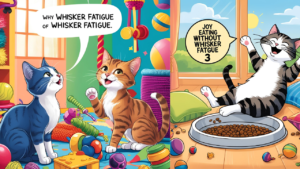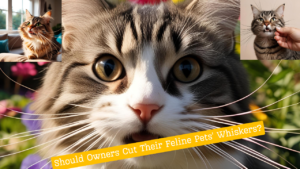Cats remain mysterious beings because their whiskers establish themselves as their most puzzling physical feature. The lengthy sensitive whiskers serve multiple important functions in addition to their attractive appearance. The health and balance functions of cats directly rely on whiskers as tools for both survival and communication. Careful observation of your cat’s whiskers enhances your ability to provide adequate care for them.
What Are Whiskers?

The facial and body areas of cats contain strong sensor hairs known as whiskers or vibrissae. Both skin and neural structures hold these hair follicles which are deeply installed into the tissue. The whiskers hold a much more complex function than basic fur features. The whiskers provide cats with strong sensory abilities that enable them to explore their surroundings effectively.
Why cat whiskers matter: How Whiskers Help Cats

1. Whiskers Improve Navigation
Why cat whiskers matter, Their whiskers enable cats to obtain information about the objects and spaces located around them. The air currents which brush against these hairs enable cats to determine what is nearby although it is dark. The special sensitivity of cat whiskers helps their movements by keeping them safe from obstacles and enabling them to spot their prey.
2. Whiskers Help Measure Spaces
The mechanism through which cats determine their passage ability through restricted areas remains a mystery to humans. Their whiskers help with this. Cat whiskers typically match the dimensions of their bodies in width. The position of a narrow gap becomes clear to cats because their whiskers provide direct touch feedback about their passage through the opening.
3. Whiskers Protect the Eyes
Whiskers above a cat’s eyes act as a defense system. A cat’s whisker movement causes automatic eye blinking when any substance comes into contact with them. The protective reflex enables cats to automatically blink their eyes to secure their vision against dirt and harm.
4. Whiskers Aid in Hunting
The hunting abilities of cats rely greatly on their set of whiskers. Whiskers on the face detect movement from prey, even in complete darkness. When cats have captured their target the whiskers play a vital role by discerning both prey position and movement for accurate biting.
5. Whiskers Communicate Emotions
Through their whiskers cats demonstrate multiple emotional states to other felines and humans. While at rest the whiskers extend normally. The whiskers of an excited or curious cat move forward from their natural resting position. The whiskers of cats retract toward the face as a sign of fear or anger. Observing your kitten’s whisker position enables you to realize their prevailing emotional state.
Whisker Fatigue: A Real Issue

Whiskers are extremely sensitive. Prolonged contact with objects around them leads cats to develop whisker fatigue. Peoples’ whiskers suffer from stress as well as discomfort when they receive too much stimulation.
Signs of Whisker Fatigue

A cat will show resistance when eating from deep eating containers.
Your cat uses its paws either to cluster food or knock it out of the bowl
Avoiding tight spaces
Acting stressed or agitated
The prevention of whisker fatigue requires wide shallow bowls for both food and water. A cat’s whiskers avoid contact with the bowl’s edges by using shallow wide containers which minimizes their stress.
Should Owners Cut Their Feline Pets’ Whiskers?

Never trim a cat’s whiskers. Skilled veterinarians understand why whisker trimming should never happen because whiskers possess strong connections to their own nervous system. Cuts to whiskers lead to disorientation and both confusion and stress as a result. A cat depends on its whiskers to achieve balance during movement and to exchange important communication signals with the environment. Cut whiskers eliminate their capacity to correctly perceive their environment.
Caring for Your Cat’s Whiskers

1. Avoid Touching Them Too Much
Whiskers are sensitive. Repeated handling of whiskers causes discomfort for your cat. Permit your cat to keep using their whiskers as they prefer.
2. Provide a Comfortable Eating Experience
Shallow feeding bowls should be used because they minimize whisker damage from hitting the edges. Your cat will experience better eating conditions while avoiding anxiety because of this prevention method.
3. Give Them Space to Explore
Cats love exploring. Create an environment that respects their whiskers. All physical objects in their habitat must be placed away from areas where the whiskers could receive excessive stimulation.
4. Check for any signs which might indicate whisker damage
The navigation system of cats becomes compromised when they have whisker injuries or when their whiskers are absent because of damage. Regular observing of broken whiskers should be followed by looking for possible medical issues or environmental factors that create stress for your cat.
A cat’s whiskers exist as much more than external attributes of its facial structure. The whiskers function to guide navigation and they assist with hunting as well as communication and protection tasks. Producing awareness about these functions helps you support your cat in the best way possible. Cats require untrimmed whiskers as well as proper feeding containers and a stress-free environment. You will maintain your cat’s well-being alongside their happiness in addition to their self-assurance when you honor their whiskers.
What are cat whiskers made of?
Cat whiskers are made of keratin, the same protein that forms human hair and nails.
Do cat whiskers grow back if they fall out?
Yes, cat whiskers grow back naturally if they fall out, but it may take several weeks.
Why do my cat’s whiskers sometimes fall out?
Occasional whisker loss is normal. However, excessive whisker shedding could indicate stress, allergies, or an underlying health issue.
Can I trim my cat’s whiskers?
No, trimming a cat’s whiskers can cause disorientation, stress, and difficulty navigating their environment.
How do whiskers help a cat see in the dark?
Whiskers detect air currents and vibrations, helping cats sense objects around them even in complete darkness.
What is whisker fatigue?
Whisker fatigue occurs when a cat’s whiskers become overstimulated, causing stress and discomfort.
How can I prevent whisker fatigue in my cat?
Use shallow, wide food and water bowls to prevent whiskers from touching the edges.
